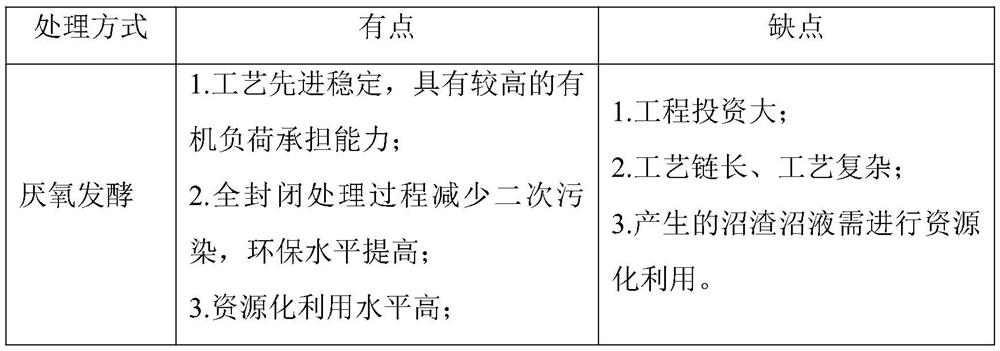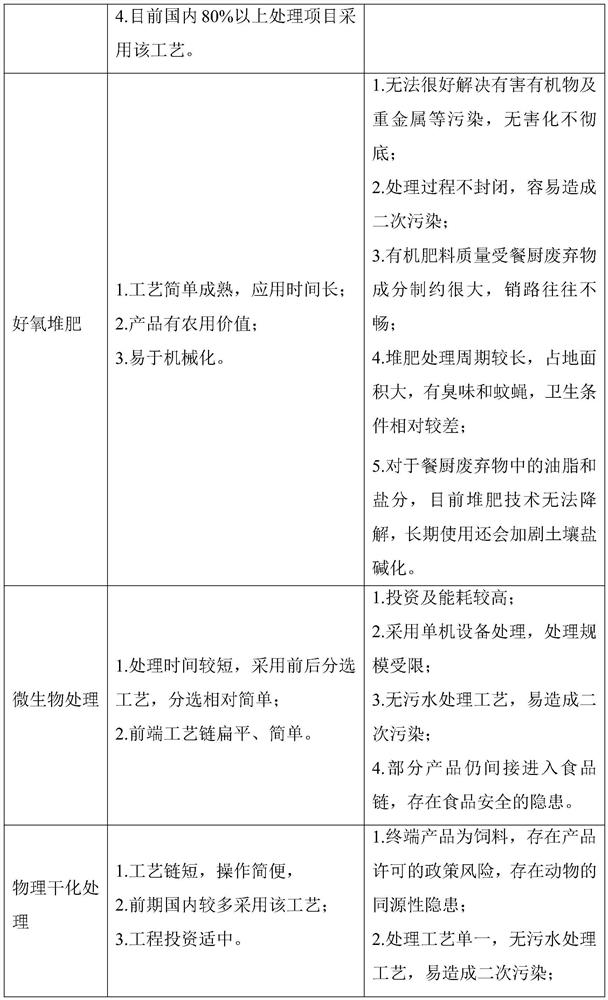Kitchen waste enzymolysis treatment process
A technology for processing technology and kitchen waste, applied in the fields of peptide preparation, chemical instruments and methods, organic chemistry, etc., can solve the problems of long processing time and long process chain, achieve controllable odor, avoid excessive enzymatic hydrolysis, The effect of reducing the blocking effect
- Summary
- Abstract
- Description
- Claims
- Application Information
AI Technical Summary
Problems solved by technology
Method used
Image
Examples
Embodiment 1
[0051] A kitchen waste enzymatic hydrolysis treatment process, comprising the following steps:
[0052] (1) Physical crushing: 50kg of kitchen waste that has been sorted and removed from plastic bags, chopsticks, and sundries passes through the crusher and crushed into a paste-like substance, with particles smaller than 60 mesh;
[0053] (2) Cooking: Add 50kg of water to the pasty material worth in step (1) according to the quality of the raw material, stir it into a slurry, heat it to 98°C while stirring, and keep it warm for 2 hours. , the reaction vessel is required to be sealed to avoid water vapor leakage;
[0054] (3) Three-phase separation: The slurry obtained in step (2) has already appeared in a three-phase state of oil, water and slag. Through three-phase horizontal centrifugation, the oil phase is separated, and a total of 14L of kitchen waste oil is collected; a small amount The solid and viscous aqueous phase goes to the next step;
[0055] (4) Biological enzyma...
Embodiment 2
[0065] A kitchen waste enzymatic hydrolysis treatment process, comprising the following steps:
[0066] (1) Physical crushing: 100kg of kitchen waste that has been sorted and removed from plastic bags, chopsticks, and sundries passes through the crusher and crushed into a paste-like substance, with particles smaller than 60 mesh;
[0067] (2) Cooking: Add 100kg of water to the pasty material in step (1) according to the quality of the raw material, stir it into a slurry, heat it to 100°C while stirring, and keep it warm for 1.5 hours. The reaction vessel is required to be sealed to avoid water vapor leakage;
[0068] (3) Three-phase separation: After step (2), the slurry has already appeared in a three-phase state of oil, water and slag. Through three-phase horizontal centrifugal separation, the oil phase is separated, and a total of 28L of kitchen waste oil is collected; a small amount of solid Enter the next step with the viscous aqueous phase;
[0069] (4) Biological enzy...
Embodiment 3
[0079] A kitchen waste enzymatic hydrolysis treatment process, comprising the following steps:
[0080] (1) Physical crushing: 80kg of kitchen waste that has been sorted and removed from plastic bags, chopsticks, and sundries passes through the crusher and crushed into a paste-like substance, with particles smaller than 60 mesh;
[0081] (2) Cooking: Add 80kg of water to the paste material obtained in step (1) according to the quality of the raw material, stir it into a slurry, heat it to 93°C while stirring, and keep it warm for 2.5 hours. When heating and keeping warm, The reaction vessel is required to be sealed to avoid water vapor leakage;
[0082] (3) Three-phase separation: After step (2), the slurry has already appeared in a three-phase state of oil, water and slag. Through three-phase horizontal centrifugal separation, the oil phase is separated, and a total of 22L of kitchen waste oil is collected; a small amount of solid Enter the next step with the viscous aqueous...
PUM
 Login to View More
Login to View More Abstract
Description
Claims
Application Information
 Login to View More
Login to View More - R&D
- Intellectual Property
- Life Sciences
- Materials
- Tech Scout
- Unparalleled Data Quality
- Higher Quality Content
- 60% Fewer Hallucinations
Browse by: Latest US Patents, China's latest patents, Technical Efficacy Thesaurus, Application Domain, Technology Topic, Popular Technical Reports.
© 2025 PatSnap. All rights reserved.Legal|Privacy policy|Modern Slavery Act Transparency Statement|Sitemap|About US| Contact US: help@patsnap.com



